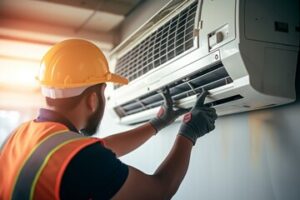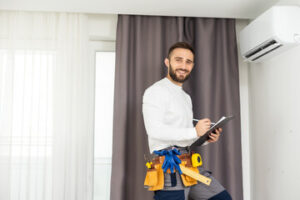HVAC Los Angeles systems include air conditioners, furnaces, air handlers and ductwork that move cool and warm air throughout a home or building. They are operated by control systems like thermostats. IAQ components like air purifiers and humidifiers are add-ons to many HVAC systems.

Air conditioning systems cool indoor air by absorbing heat from it and releasing cooling energy into the environment. They also ventilate the system to replace stale air with fresh outdoor air.
If you’re having trouble getting your furnace to start working, there are a few things you can try. Check to make sure that the thermostat is in “heat mode,” and adjust it up a few degrees. Also check that the a.m. and p.m. settings are correct, since these often get changed when you have a power outage and the thermostat reverts to its default program. Check the wiring to make sure that nothing has come loose or broken, particularly if you’ve done any remodeling in your home recently. You can also open the thermostat and gently blow out any dust, but be careful not to damage the thin wires.
Another possibility is that your gas valve has been closed. To check this, follow the flex pipe from the gas meter to the furnace, which will connect to black metal pipe with a valve. The valve will likely be in the off position, and will need to be turned on. If this doesn’t work, your problem may be a bit more serious and you’ll need to call in an expert.
The other possibility is that the fan setting on the thermostat has been changed to “fan continuous.” This will cause the fans to run constantly, and will not allow the heater to turn on. It’s worth checking this, although you should keep in mind that the blower motor is not the same as a fan. You can also look in the ducts for any handles that protrude out, which are the dampers that control air flow.
Your last resort, assuming the above steps have not solved your issue, is to reset the ignitor/sensor. Consult your user manual for instructions on how to do this, as it’s a fairly technical process and requires you to remove the front panel of your furnace.
Depending on the results of these troubleshooting steps, you may have to replace a blown fuse or tripped circuit breaker. Then you should be able to get your furnace up and running again. If not, it may be time to call in a professional from Billings HVAC.
The Cooling Isn’t Working
One of the most important functions of HVAC, especially in a home, is cooling. Some systems cool with a conventional air conditioning unit, while others (including heat pumps) cool with a device similar to the one used in a furnace. Either way, the purpose is to grab warm indoor air and move it outside, which lowers the indoor temperature.
The main parts of an HVAC system that are involved in cooling are the indoor air handler and outdoor condenser. Forced-air systems (which use ductwork to distribute the air) have an air handler that houses some of the AC components, while central and split air conditioners have separate units for heating and cooling.
Most air conditioners also have a drain pan that collects excess water. If the drain pan gets full, it triggers a float switch that shuts off the AC. This is an important safety feature that helps prevent flooding in your house, but if it happens frequently, it may be because the air conditioner is not big enough for your home.
Another common problem is that the blower motor is not working, which can cause the system to fail to turn on. This can be caused by a number of things, including a dirty air filter or clogged vents. In some cases, a blower fan motor can simply burn out.
It’s also possible that the AC isn’t getting power. This can be due to a number of things, but it’s often because the breaker box has been tripped. Try to find the breaker that’s linked to your HVAC system, and flip it back on.
There are also some problems that can be difficult to fix on your own, but which are still relatively affordable. For example, if the capacitors inside your outdoor unit are on the fritz, you might need to get them replaced by an HVAC pro. These components — which look like giant batteries — give the motors their initial push to start running, and they have a limited lifespan.
Other HVAC-related problems can be more expensive, such as an a/c compressor that has failed or an outdoor unit that has lost refrigerant. In these instances, you will need to have the entire unit inspected and repaired by an expert.
The Thermostat Isn’t Working
Your thermostat is a key piece of equipment that regulates your HVAC system. So, when it’s not working correctly, it can throw off the whole system. Fortunately, there are some simple things you can do to troubleshoot what might be wrong with your thermostat and get it back up and running.
First, check to see if the batteries are dead. If they are, replace them and power up the thermostat. If that doesn’t work, try removing the cover and checking to see if the wires are plugged in. If you’re not comfortable messing around with the wires (it can be dangerous), you can call in a professional to open up the thermostat and see what’s going on.
Another common thermostat problem is that the fan is continuously running, even when the temperature settings are turned off. This can occur if the setting is on “auto,” which means the blower will always run, even when the system isn’t heating or cooling.
If you’re noticing that the temperature on the thermostat doesn’t match what it feels like in your home, it could be an issue with the sensors. These can be caused by a number of factors, including improper placement and dust build-up. If the thermostat is constantly recalibrating itself, it can also cause problems with its readings.
A tripped circuit breaker can also cause your thermostat to stop working. If this is the case, you’ll need to locate your breaker box and find the breaker that controls your thermostat. Switch it off and then on again to see if this fixes the issue.
Your thermostat has many electrical connections that serve various functions, from displaying the temperature to communicating with your HVAC unit. These can become loose, especially if you’ve had the thermostat for several years or it was installed incorrectly. Additionally, vibrations or rodents in the attic can affect these connections and lead to issues with your thermostat. If the above steps don’t solve your problem, it’s time to call an HVAC specialist. They’ll have the training and tools needed to figure out what’s going on with your thermostat and fix it quickly.
The Ductwork Isn’t Working
If you notice that some rooms in your home aren’t getting heated or cooled as well as other areas, the problem may lie with your air ducts. This is because your HVAC system might be working overtime to keep up with a limited amount of air being pushed through the vents. A professional can use a special camera to inspect the ductwork for leaks or blockages that are impeding the flow of air.
If the ducts are dirty, there’s a good chance that you won’t be able to solve the problem by simply cleaning them. While air filters are designed to keep most dust, dirt and other particles out of your HVAC system, there’s no limit to the amount of small debris that can accumulate in a duct over time. If this builds up, it can cause a variety of issues including poor airflow and lowered indoor air quality.
Other issues with ductwork include problems with sizing. If your ducts are too big, they’ll struggle to maintain the required pressure in the system and cool or hot air will have difficulty reaching all areas of the house. Conversely, if your ducts are too small, they won’t be able to adequately distribute the desired temperatures.
Another common issue is that there aren’t enough return or supply vents in the home. It’s important to have an adequate number of both so that the blower can suck in return air from all the room in the house, helping to balance the pressure in the ductwork and improve the HVAC airflow.
A final issue that sometimes occurs is that the ductwork itself may be damaged. This can be caused by physical obstructions, like furniture blocking a vent or a buildup of dust over time. In this case, it might be possible to fix the problem by rearranging furniture or cleaning the vents. In more serious cases, it might be necessary to replace the ductwork entirely.
